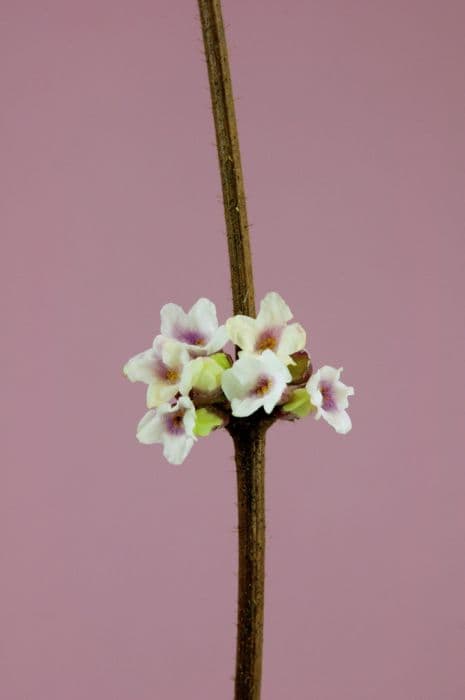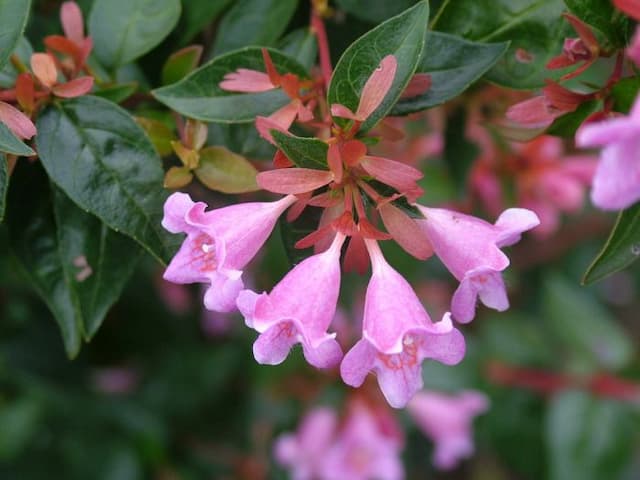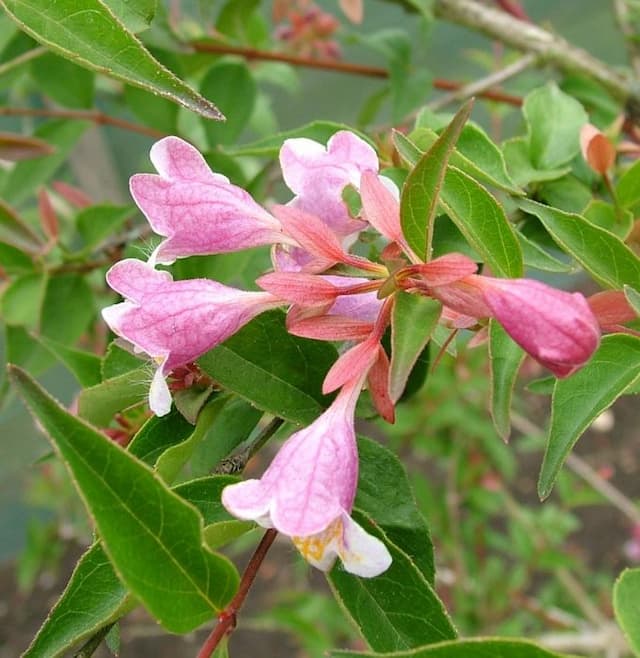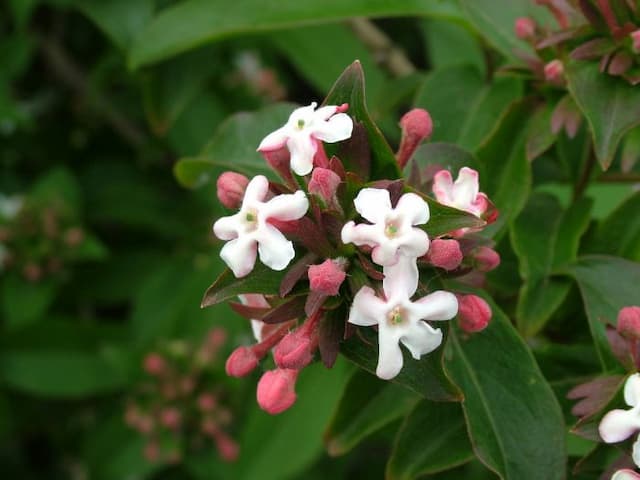Woodbine Lonicera setifera 'Daphnis'

ABOUT
The Lonicera setifera 'Daphnis' is commonly known as the honeysuckle. This plant is renowned for its attractive and highly fragrant flowers. The flowers of 'Daphnis' are typically a vibrant yellow color, adding a splash of brightness to the landscape. These flowers may also exhibit hints of orange or pink, and they are tubular in shape, which makes them especially appealing to hummingbirds and butterflies that are drawn to their nectar. The foliage of the honeysuckle consists of oval-shaped leaves that are a deep, rich green, providing a lush backdrop for the colorful flowers. The leaves may appear in pairs along the stems, creating a symmetrical appearance. Depending on the variety, the leaves can also be semi-evergreen or deciduous, changing color in the fall before dropping. Additionally, as the flowering period concludes, the honeysuckle may produce small red or black berries, which can provide food for birds and other wildlife. The plant has a twining habit, often wrapping itself around trellises, arbors, or other structures, lending it to use as a decorative climbing plant. The stems are slender and may exhibit a woody texture as the plant matures. The overall visual impression of the honeysuckle 'Daphnis' is one of a charming and dynamic plant, providing multi-season interest with its blooms, foliage, and potential fruit, and contributing both visual beauty and fragrant delight to gardens and landscapes.
About this plant
 Names
NamesFamily
Caprifoliaceae
Synonyms
Emerald Belle Honeysuckle, Daphnis Honeysuckle, Setifera Honeysuckle
Common names
Lonicera setifera.
 Toxicity
ToxicityTo humans
The Lonicera setifera 'Daphnis', commonly known as honeysuckle, is not typically known for its toxicity to humans. However, some species of honeysuckle may contain saponins or cyanogenic glycosides, which can be mildly poisonous. If ingested in large quantities, parts of the plant, especially berries, might cause stomach upset, diarrhea, and vomiting. It is always advisable to avoid eating parts of ornamental plants due to potential toxicity risks.
To pets
The Lonicera setifera 'Daphnis', known as honeysuckle, can pose a risk of toxicity to pets if ingested. Although this particular variety is not well-documented for toxicity, some honeysuckles contain saponins that can be toxic to dogs and cats when consumed. Symptoms of honeysuckle poisoning in pets may include gastrointestinal upset such as vomiting and diarrhea. In more severe cases, ingestion may lead to lethargy or more serious complications. It is recommended to prevent pets from chewing on or ingesting any part of the plant.
 Characteristics
CharacteristicsLife cycle
Perennials
Foliage type
Deciduous
Color of leaves
Green
Flower color
Yellow
Height
6-10 feet (1.8-3 meters)
Spread
6-10 feet (1.8-3 meters)
Plant type
Climber
Hardiness zones
7
Native area
Southeastern United States
Benefits
 General Benefits
General Benefits- Ornamental Appeal: Lonicera setifera 'Daphnis', commonly known as honeysuckle, has attractive flowers and foliage, making it a popular choice for gardens and landscapes.
- Wildlife Attraction: Its fragrant flowers attract pollinators like bees and butterflies, enhancing local biodiversity.
- Privacy Screen: When planted in a row, honeysuckle can form a dense screen that offers privacy and reduces noise pollution.
- Soil Erosion Control: The plant's root system helps to stabilize soil, preventing erosion on slopes and banks.
- Shade Provider: Larger varieties can offer shade in garden areas, making it a comfortable space during sunny days.
- Seasonal Interest: Honeysuckle has seasonal features such as spring and summer blooms, and some varieties have colorful autumn foliage or berries.
- Hardiness: It is generally hardy and capable of surviving in a range of climates and soil types with minimal care.
- Fast Growth: Honeysuckle is known for its rapid growth, allowing for quick establishment and coverage.
- Fragrance: The flowers emit a pleasant scent that can add an aromatic element to a garden or landscape.
- Versatility: Can be trained to grow on trellises, fences, or even as ground cover, depending on the gardener's needs.
- Ease of Propagation: Honeysuckle can be easily propagated from cuttings, allowing gardeners to expand their plantings without additional cost.
 Medical Properties
Medical PropertiesThis plant is not used for medical purposes.
 Air-purifying Qualities
Air-purifying QualitiesThis plant is not specifically known for air purifying qualities.
 Other Uses
Other Uses- Crafting Material: Flexible twigs of the honeysuckle can be woven into small baskets or used as natural ties in garden trellising.
- Perfumery: The flowers of honeysuckle can be infused in oil to capture their sweet fragrance, which can be used in homemade perfumes and scented candles.
- Garden Structure: Because of its climbing habit, honeysuckle can be trained over pergolas or archways to create living garden structures.
- Edible Flowers: While not widely recognized as a food source, the nectar from honeysuckle flowers is a sweet treat and can be used as an edible garnish.
- Photography Subject: The blossoms and the intricate climbing pattern make honeysuckle a popular subject for botanical photographers.
- Wildlife Shelter: Dense thickets of honeysuckle provide nesting sites and shelter for small birds and other wildlife.
- Natural Dye: The flowers and berries of honeysuckle can be used to create natural dyes for fabrics or artisanal crafts.
- Education: Honeysuckle is a useful plant for educational purposes in botany and horticulture, illustrating plant growth patterns and pollinator interactions.
- Erosion Control: The robust root system of honeysuckle can help stabilize soil and prevent erosion on slopes or banks.
- Decorative Displays: Fresh or dried, honeysuckle branches can be used in floral arrangements for their aesthetic appeal and fragrance.
Interesting Facts
 Feng Shui
Feng ShuiThe Lonicera setifera, commonly known as Honeysuckle, is not typically used in Feng Shui practice.
 Zodiac Sign Compitability
Zodiac Sign CompitabilityThe Honeysuckle is not used in astrology practice.
 Plant Symbolism
Plant Symbolism- Love and Affection: As a type of honeysuckle, Lonicera setifera 'Daphnis' often symbolizes devoted affection and the bonds of love, referencing the way the vines and flowers of honeysuckles tend to entwine.
- Fidelity: The durable and long-lasting nature of honeysuckle blooms can represent faithfulness in relationships, suggesting a steadfast and loyal connection.
- Generosity: Honeysuckles are abundant in their production of nectar, which is generously offered to pollinators, signifying a generous attitude and the willingness to give to others.
- Protection: Some cultures see the honeysuckle as a symbol of protection because of its robust growing habits, where it can create a natural shelter and safe haven for wildlife.
- Friendship: The intertwined growth pattern of honeysuckles can also symbolize the close bonds of friendship, reflecting interconnectivity and mutual support.
 Water
WaterThe Mountain Fly Honeysuckle (Lonicera setifera 'Daphnis') prefers regular watering to maintain moist soil, especially during dry spells. It should be watered deeply once a week, with about 1 to 1.5 gallons per watering session for mature plants. During hot summers or in particularly dry climates, increase watering frequency to twice a week. Newly planted or younger specimens will require more frequent watering, often several times a week, to establish a healthy root system. In the winter months, you can reduce the amount of water as the plant goes dormant and requires less moisture. Always check the soil before watering; it should be moist but not saturated.
 Light
LightThe Mountain Fly Honeysuckle thrives in full sun to partial shade conditions. Ideally, it should receive at least 6 hours of direct sunlight daily but can tolerate some afternoon shade, which can be beneficial in hotter climates. The best spot for the plant is one that receives morning sunlight and dappled or partial shade in the afternoon to protect it from intense heat.
 Temperature
TemperatureThe Mountain Fly Honeysuckle can survive in a wide range of temperatures but prefers moderate to cool climates. It is hardy in USDA zones 4 through 8, which means it can withstand minimum temperatures ranging from -30 to 20°F. The ideal temperature range for this plant is between 60 and 75°F. It may require protection from frost and extreme cold by mulching around the base of the plant.
 Pruning
PruningPruning the Mountain Fly Honeysuckle is essential to maintain its shape, encourage growth, and improve air circulation. Prune immediately after flowering to avoid cutting off the next year's buds, as it blooms on old wood. Pruning can be done annually, removing any dead, diseased, or tangled branches, and to shape the plant. Thin out crowded areas to allow light and air to reach the interior of the shrub.
 Cleaning
CleaningAs needed
 Soil
SoilThe honeysuckle (Lonicera setifera 'Daphnis') prefers well-draining soil with organic matter, such as a mix of loam, peat, and sand. The ideal pH should be between 5.5 and 7.0 for optimal growth.
 Repotting
RepottingHoneysuckle, including Lonicera setifera 'Daphnis', doesn't require frequent repotting and can be done every 2-3 years, or when the plant outgrows its container.
 Humidity & Misting
Humidity & MistingHoneysuckle thrives in moderate humidity levels but is quite adaptable. Aim for relative humidity around 50-60% for optimal growth.
 Suitable locations
Suitable locationsIndoor
Place in bright, indirect light and ensure good air circulation for honeysuckle.
Outdoor
Plant in sun to part shade and protect from strong winds for honeysuckle.
Hardiness zone
4-9 USDA
 Life cycle
Life cycleLonicera setifera 'Daphnis', commonly known as the Fly Honeysuckle, begins its life cycle as a seed, which upon finding suitable moist soil and appropriate environmental conditions, germinates to produce a small seedling. As it transitions to the vegetative stage, the plant develops a root system and shoots that grow into stems and leaves, harnessing energy through photosynthesis. During the reproductive stage, the Fly Honeysuckle produces fragrant flowers that attract pollinators, leading to fertilization and the development of berries. These berries contain seeds, which, when dispersed by birds or other mechanisms, find new locations to germinate and begin the life cycle anew. The plant enters a period of dormancy during colder months if it's located in a region with seasonal changes. Throughout its life, the Fly Honeysuckle may also spread vegetatively through layering or cuttings taken from its stems.
 Propogation
PropogationPropogation time
Spring-Early Summer
For Lonicera setifera 'Daphnis', commonly known as honeysuckle, the most popular method of propagation is through cuttings. The ideal time to take cuttings is during the late spring or early summer when the plant’s growth is most vigorous. A healthy, non-flowering shoot should be selected and a cutting of about 5 to 6 inches (approximately 13 to 15 cm) should be taken. The lower leaves of the cutting should be removed, and the cut end dipped in a rooting hormone powder to encourage root growth. The cutting should then be planted in a pot filled with a mix of peat and perlite, ensuring that it is kept moist and in a warm, shaded spot until roots have developed, which typically takes several weeks. Once the cuttings have rooted successfully, they can be transplanted outdoors to their final location.








![Himalayan honeysuckle [Golden Lanterns]](/_next/image?url=https%3A%2F%2Fplants-admin.emdemapps.com%2Fimages%2Fplants%2F%2Fimages%2F604b55302cc87.png&w=640&q=75)
